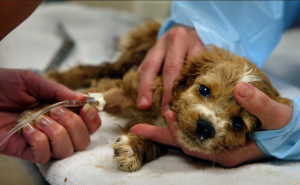
Imagine being stuck in a room for days on end. Your only friend is someone dressed in a weird plastic gown with a face mask and gloves. You don’t get to go outside – you just stay here, get your medications and be wiped clean. The smell is overpowering, even to you. All you want to do is play and go for a walk, but you can barely move. This is what parvovirus is like from a dog’s point of view.
Parvovirus is a highly contagious, often fatal disease of unvaccinated dogs. It is spread by oral and nasal contact with infected faeces. The highest risk group are puppies between the age of 6 weeks to 6 months, and any dog that is unvaccinated. Older dogs can be infected however it is less likely. Parvovirus can be seen all year round but is much more prevalent in the warmer months.
Parvovirus attacks the gastrointestinal tract and immune system of dogs. The virus affects the lining of of the gut and causes loss of fluid, inability to absorb nutrients and enables bacteria to enter the blood stream. Signs of infection include lethargy, loss of appetite, fever, dehydration, vomiting and diarrhoea – both of which can be severe, bloody and malodorous.
Without treatment, fatality rates approach 90% and death can occur in 2-3 days. Prompt and aggressive treatment with intravenous fluids and medications to help repair the damage done by the virus is required. Treatment and recovery can take weeks.
Prevention is achieved by vaccinating your puppy three times in the between the 6 week to 6 month of age period, and following it up with yearly boosters. During the puppy vaccination period is it ideal your dog not be in public areas or come into contact with any non-vaccinated dogs; this gives your pup the highest chance of building a suitable immunity to defend against infection. The disease is very stable in the environment and can persist for over a year in soil and faeces. It can even be spread by your shoes. The best way to prevent this is to clean the area with a bleach & water dilution (1:30). Remove any bedding or bowls, and discard all faeces from the infected dog. Before bringing any new dogs onto the property, make sure the are fully vaccinated, and preferably older than 6 months, to prevent going through this tragic scenario again.
You may have seen in the news lately a new strain of parvovirus, CPV-2c, has been detected. It is a variant of the original CPV-2 strain. The vaccines used protect against CPV-2 & CPV-2b, and have recently been shown to protect against the newest strain CPV-2c. Vaccination is crucial for prevention against the powerful & deadly parvovirus.
